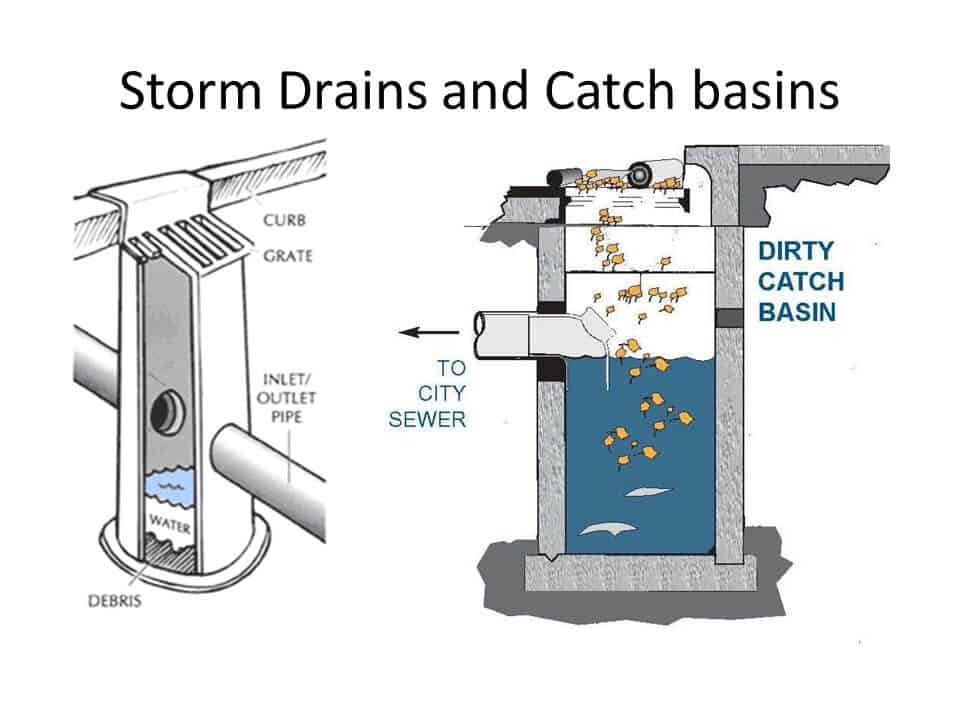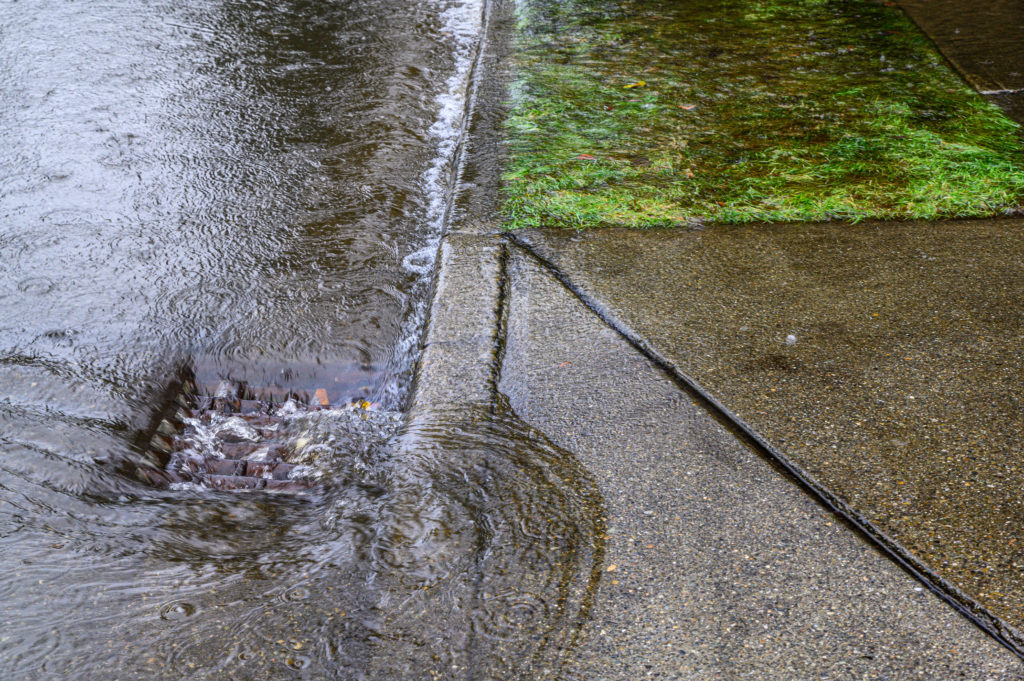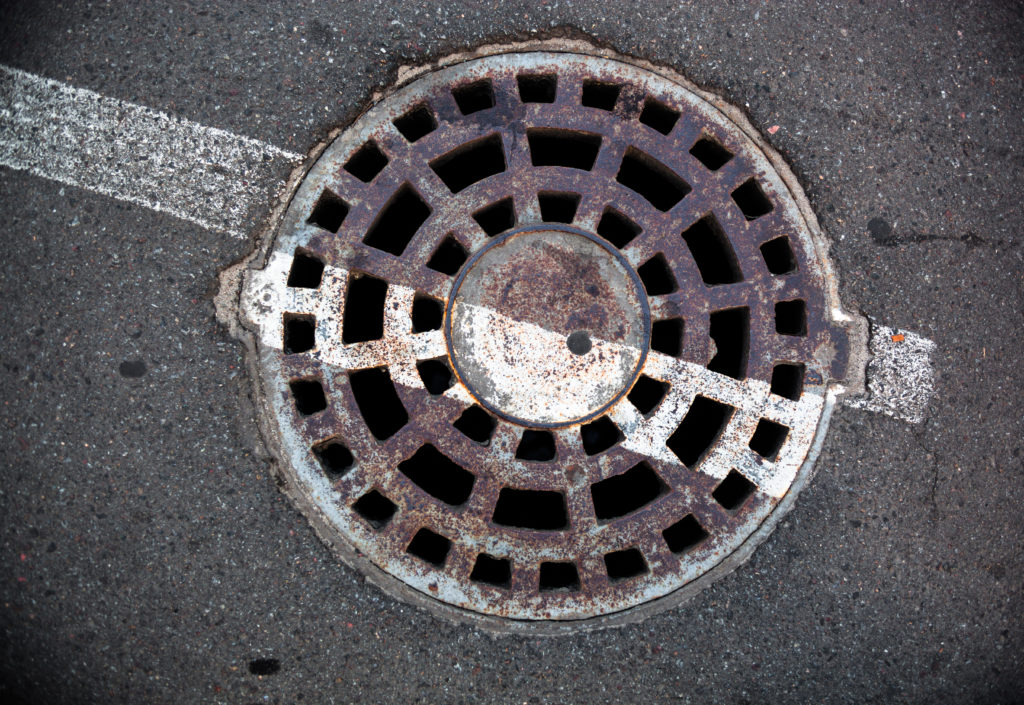What Are Catch Basins?
Are Catch Basins Different from Storm Drains or Storm Sewers?
Catch Basins, Storm Sewers and Storm Drains are used interchangeably in everyday speech. Most people have never heard of a catch basin and instead call catch basins storm drains or storm sewers.
Which is fine if you’re just talking with your neighbor but if you’re talking about a commercial asphalt project we need to get a little more specific.
In short, Catch Basins are holes in the ground that “catch” the rainfall or any runoff surface water. Storm Drains are a type of Catch Basin, but are typically along the sides of roads to deal exclusively with storm runoff. Storm Sewers are the systems that carry the water away.
Catch Basins are PARTS of Storm Drains and thus of a Storm Sewer SYSTEM. And a vital part, too, because they’re the things that catch the water.
How are Catch Basins and Storm Sewers Constructed?

The Catch Basin is made from a combination of steel and precast concrete or porcelain. It’s connected up to the storm sewer system by a series of pitched pipes. The pipe connecting the catch basin to the storm sewer system is typically about halfway up in the Catch Basin.
When functioning correctly, the catch basin is a remarkably elegant and time tested solution to stormwater runoff. The water comes in, the sediment settles to the bottom of the catch basin, the water then reaches a certain volume where it hits the pipe, and then it begins to drain into the pipe which connects to the main storm sewer line and then off to the main outlet.
When it works, it’s like you don’t even know the whole system is there. When it doesn’t work, that’s when you need to make a call to a professional.
Why Do Catch Basins and Storm Sewers Break?
Catch Basins and Storm Sewers degrade over time because of lots of different factors but the main reason they fail is just because of time and volume of water.
Sometimes, water can leak out of the bottom of the catch basin and erode the earth beneath it, leaving a void. The catch basin then sinks into the void and you’ll see a hole developing in your parking lot.
In Minnesota and other places in the Frozen Northlands, you have to deal with quite a bit of frost. And sometimes that leads to Frost Heaving which we’ve talked about at length. Anything in the ground can get pushed around by heaving if it’s close enough to where it’s happening.
For example, an ice lens could be building up underneath your catch basin, which pushes it up during the wintertime. Then, when it thaws, the ice lens leaves a void and the catch basin sinks down lower than where it was before.
That’s why you often see so many parking lots with sunken catch basins. There are a lot of ways for it to sink. And after that happens, it’s just a matter of time before it becomes a big problem.

Is it a big problem for my parking lot when my Catch Basin or Storm Sewer breaks?
Yes, because if it’s sinking or deteriorating to the point where it’s no longer transferring storm runoff into the storm sewer system, then you’ve got nothing more than a hole in the ground to collect rainwater. And that’s not what you want.
If your catch basin sinks down too much, eventually the connection to the main storm sewer line is broken. Now it’s just going to collect water whenever it rains and just keep collecting it until it overflows. And when it overflows that’s going to mean more erosion, so the problem starts to compound itself.
If this happens, the first call you make will likely be to a plumber who will come out and inspect the catch basin. Depending on the plumber’s diagnosis, you could need a full catch basin repair.

Catch Basin and Storm Sewer Repair
If you need to replace your catch basins in an asphalt parking lot, then you’ll need a company that can handle three things: concrete, asphalt and excavation. Handily enough, that’s exactly what Goodmanson Construction does.
What Equipment Do you Need to Repair Catch Basins and Storm Sewers?
You need heavy equipment operators to do the demolition and excavation for the affected area. You’d be surprised at how deep some catch basins can go!
Depending on how bad the damage is to the basin itself, you may need to repair only part of it or replace it with a new precast catch basin. You’ll also need pipe to reconnect it to the sewer system. Then you’ll need to grade insulated concrete (our preference) or asphalt around the catch basin to get the water to flow down into it.
When you’re dealing with a project like this, you want a company who can do all of it. Goodmanson Construction will do all concrete, asphalt and excavation work on any catch basin repair in the Twin Cities.
Can You Give Me an Outline of the Typical Process to Repair or Replace a Catch Basin?
Here’s an example we took from one of our most recent jobs.
How To Repair a Catch Basin:
- Saw Cut and remove Concrete/Asphalt around catch basin
- Install Adjustment Rings and concrete collars
- Re-Grout all Connections between Sewer pipes and Catch Basin
- Re-Install Cast Iron Inlet Grate
- Pour new reinforced Concrete sloped down to catch basin.
How To Replace a Catch Basin:
- Saw cut and remove Concrete/Asphalt around catch basin
- Excavate area around the catch basin
- Disconnect catch basin from storm sewer system
- Demolish and remove excavated catch basin
- Install new precast catch basin
- Install Adjustment Rings and concrete collars
- Re-Grout all connections between Sewer pipes and Catch Basin
- Replace all material taken during excavation
- Re-Install Cast Iron Inlet Grate
- Pour new reinforced concrete sloped down to catch basin
As you can tell, replacing a catch basin is a bit more work.

How Long Does it Take to Repair a Catch Basin?
Here’s where we get to brag a little, because it really depends on two factors: the first is how extensive the damage is and the more important factor is who you get to repair it.
A company that has to subcontract out a lot of the work, or a general contractor, will have to coordinate multiple schedules in order to get a single project done. If you want something done fast, and you want something done right, and where one company takes responsibility for everything, you want Goodmanson Construction. Goodmanson Construction offers a full line of services for parking lots and catch basins.
For us, repairing or replacing a catch basin takes 4 days. One day to do the work and three more for the concrete to cure to be ready.
How to Reduce Downtime at Your Facility
When one contractor handles all the aspects of the project, you’re going to get things turned around faster and you’re going to avoid downtime at your facility. Your parking lot will be usable again in a matter of days, not weeks.
Also, as a matter of customer service, if for any reason you need to talk to us about the catch basin, we’re the only call you need to make.

